More about Thimbles





Magdalena and William Isbister.
Grave 910 Hans Tober
Hans Tober was born around 1527, he was apprenticed to Jacob Rosenberger, who was later to become his father in law. In 1541 and after a four year apprenticeship he became a journeyman thimble maker. His time as a journeyman was reduced and this was probably because his father was a master thimble maker. He married in 1552 and became a master in 1554. He had one son, Hans, with Margaretha. By 1569 he was living in a house on the corner of the Rotschmiedgasse and Judengasse on the Sebald side of the river Pegnitz. His father in law sold his property, except for his shop, on the north side of the river and moved to the Lorenz side and thus qualified for burial in the Rochus cemetery. He therefore transferred his plot in St Johannis (Fig 29) to Hans in 1580 (5). Hans was a very successful thimble maker and on two occasions applied to the Thimble maker’s Guild to be able to employ more apprentices but he was turned down on both occasions. He also applied on two occasions to make iron thimbles but these requests were turned down too. Hans Tober was also a Meistersinger of Nürnberg.
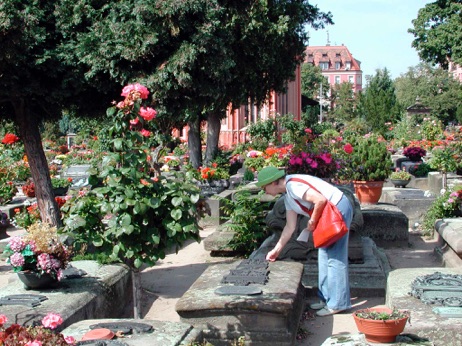
Fig 29
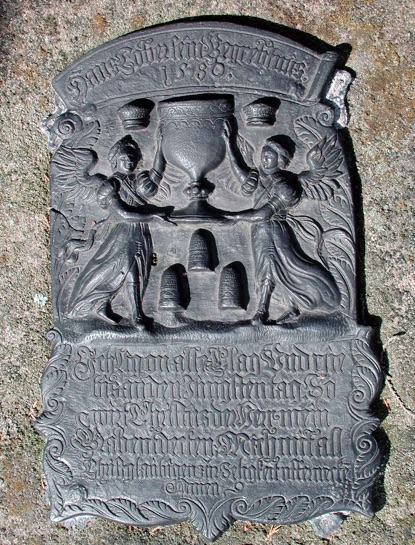
Fig 30
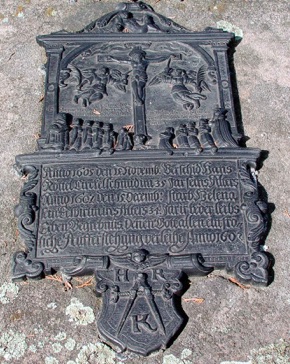
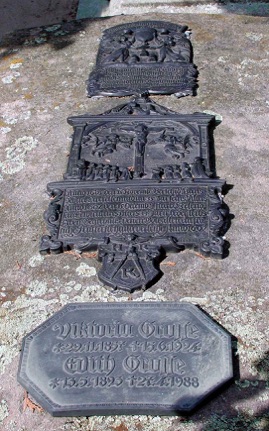
Fig 31 Fig 32
There are three plaques on this gravestone, the Tober epitaph (Fig 30), a 17th century plaque (Fig 31) belonging to Hans Rottel (1605) and a small octagonal plaque for the Grosse family 1857-1988 (Fig 32).
On top of the Tober epitaph are the words:
‘Hans Tober sein Begrebtnus.
1580.’
(Hans Tober’s burial place 1580)
Then there are two angels, in long dresses wearing wreaths on their heads and holding a goblet above three thimbles. A further two thimbles are to be seen above the angel’s heads. Below this:
‘Jch Lig on alle Clag Vnd rue
bis an den Jûngsten tag. So
wirt Christus der Herr mein
Grab entdecken, Mich mit all
Christglaubigen zur Seligkeit vfferuecke
Amen’.
(I lie without misery and rest until the youngest (Resurrection) day. So Christ the Lord will discover my grave and will raise me to eternity with all Christian believers. Amen.)
The relationship between the Grosse family and Hans Tober is not known.
Grave 917 Paulus Gundlachs
We have not been able to find any evidence regarding the trade of Paulus Gundlachs although he is thought to have been a thimble maker (personal communication, Wolf-Dieter Scholz). The grave now seems to contain the remains of three families (Fig 33): Gundlach, Hauer and Riffel and each has a plaque. It is not known whether the families are related. The main plaque belongs to Paulus Gundlachs and is a rather grandiose epitaph in three parts (Fig 34). The main upper medallion (Fig 36) seems to contain a depiction of a fish about to spit out a person (probably Jonah and the whale) supported by five naked Genii. The left Genius is holding an anchor and a lying lamb and the right Genius is holding a chalice and a cross. Above are more Genii playing and hugging and one is carrying a bag of money, which is being spilt, in her right hand and a smoking urn in her left hand. This is supposed to signify man’s good points; belief, love, hope, patience, compassion and generosity (15). Above the Genii is a figure on a boat in another smaller medallion (Fig 35) (probably a representation of the resurrection) and the words ‘Ich ware todt, und siehe ich lebe’. This means ‘I was dead and look I live’.
The middle rectangular portion (Fig 37) contains the words:
‘Mortvvs en vivo
Des Erbaren Paulus Gundlachs
Vnd Vrsula ein Geborne Kochin,
Seiner lieben Ehwirttin vnd dessen Nachkommen Begrebnus’
(Dead behold to live. The honourable Paulus Gundlach and Ursula born Kochin his dear wife and their descendant’s burial place)
Under the inscription is a third medallion. Below an inscription (Fig 38) ‘Alles inn gedvlt’ (all in patience), is a jousting helmet out of which a man (Paul Gundlach) with his plants in both outstretched hands comes. Below there are two shields. The left shield depicts half a bearded man in a tight habit with a belt and an Albanian hat arising from a mountain. His hands are outstretched and each holds a single plant with roots and three leaves. The right shield contains a complete bearded man, on top of a hill and wearing a tight camisole and wide full trousers. He has a long kitchen knife by his side and cooking spoons in his outstretched hands.
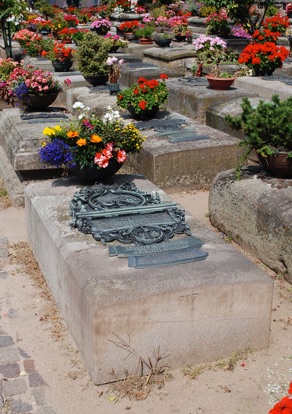
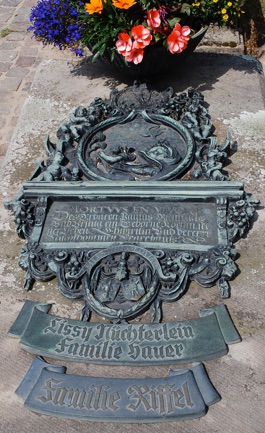
Fig 33 Fig 34
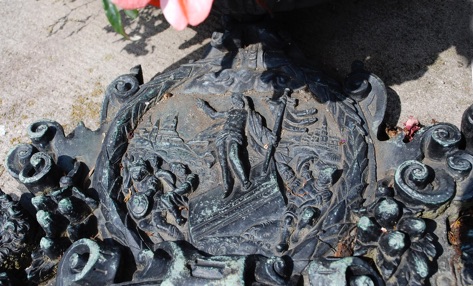
Fig 35
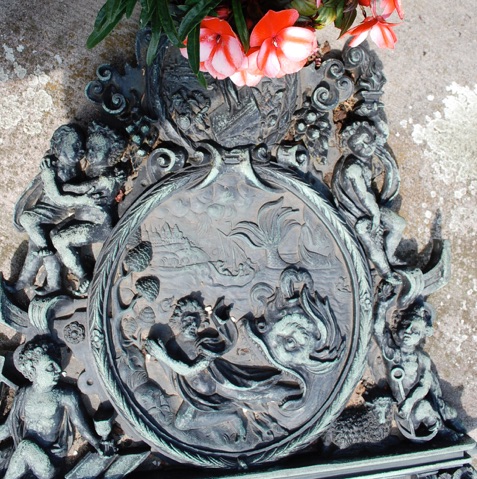
Fig 36
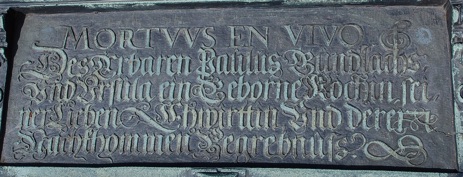
Fig 37
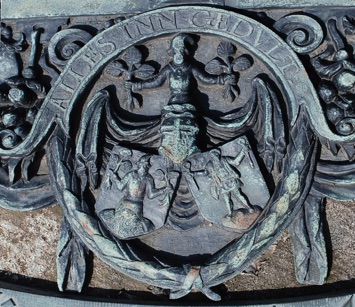
Fig 38
The Haur and Riffel plaques lie below the Gundlachs plaque (Fig 39).
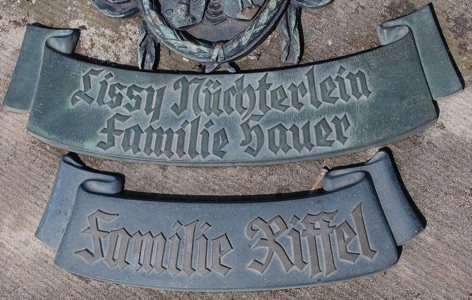
Fig 39
Grave 1103 Hannsen Schmids
Two plaques are clearly missing from this grave (Fig 40). The only remaining plaque belongs to Hannsen Schmids (Fig 41). A rectangular plaque bears the inscription:
‘Des Ersamen Hanntzen
Schmids, Fingerhutmachers,
Frau Vrsula seiner Ehewir
thin vnd Ihrer beden Leibes
Erben Begräbnus 1656’
(The honourable Hannsen Schmids, thimble maker, Frau Ursula his wife and their natural children’s burial place. 1656.)
Below the inscription are two thimbles and a skull and cross bones. The date seems to have been engraved at a later time, as was often the case, and since there was only one date is it possible that all the family died at approximately the same time?
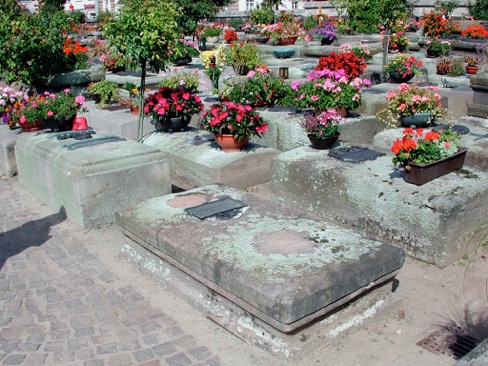
Fig 40
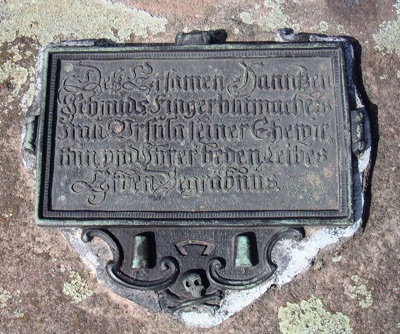
Fig 41
Grave 1231 Matthes Kesslers
There are two plaques on this grave (Fig 42). In 1591 Matthes Kesslers, who was a thimble maker, bought the grave although the dates relating to his family were never entered on the epitaph (Fig 44). Later Matthas Kessler, a cooper (barrel maker), and his wife Barbara were buried in the same grave in 1630 (Fig 43). It is presumed that the two were father and son but the names are not exactly the same. In the Middle Ages several different spellings and characters were used for the same words and it is therefore very difficult to be absolutely certain regarding the meaning or similarity of a particular word or words from this era.
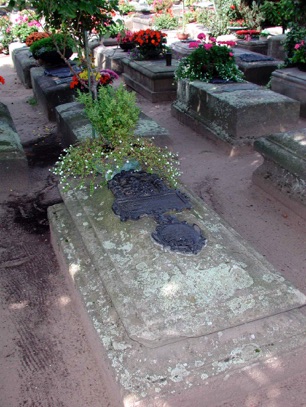
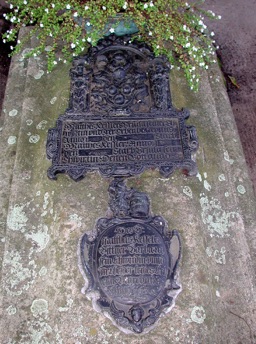
Fig 42 Fig 43
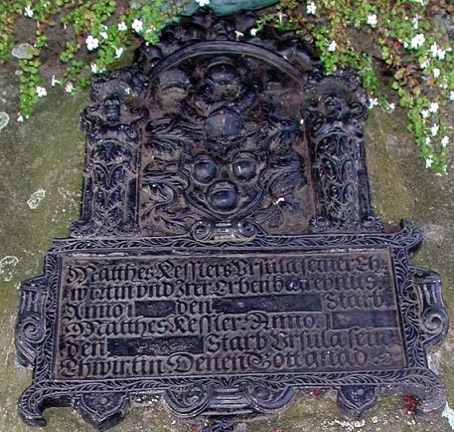
Fig 44
In a decorated rectangular plaque (Fig 44) is written:
‘Matthes Kesslers Vrsula seiner Eh’’
wirtin vnd Jrer Erben begrebnus.
Anno .1[ ] den [ ] Starb
Matthes Kessler. Anno .I[ ]
den [ ] Starb Vrsula sein
Ehwirtin. Denen Gott gnad’
( Matthes Kesslers’ Ursula, his wife and their inheritors burial. In the year 1[ ] on the [ ] Matthes Kesslers died. In the year 1[ ] on the [ ] Ursula , his wife died. May God give them grace)
The spaces were for dates to be inserted.
Above the inscription is a portal flanked by two caryatids with full baskets of fruit on their heads, acanthus leaf skirts and scrolls instead of feet. Above the portal are two lying, sleeping genii with a skull between their heads. Within the portal is a crest with three tubs with handles below a knight’s helmet from which two clothed arms protrude holding a further tub on either side of which is a thimble (Fig 45).
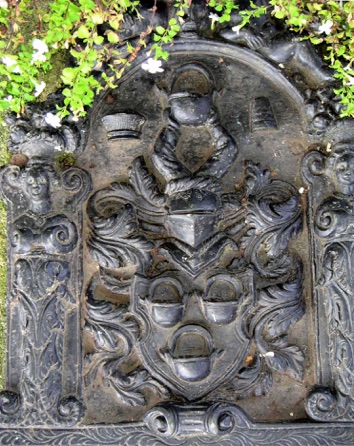
Fig 45
The second plaque depicts a cooper above a medallion containing the epitaph for Matthas Kessler (Fig 43).
Grave 1416 Cuncz Hofmon
Cuncz Hofmon was possibly a thimble maker and a publican (personal communication, Dieter Pröbster). There are two plaques on the grave (Fig 46). The earliest plaque (Fig 47) comprises ashield containing a symbol (Meisterzeichen or ‘Hauszeichen’ [family or house sign]) below a rectangular epitaph:
‘1532 Verschid der Erber
Cuncz Hofmon dgg’
(1532 The honourable Cuncz Hofmon died dgg)
‘dgg’ is an abbreviation for ‘Denen Gott genad’ which means ‘to whom God gives grace’
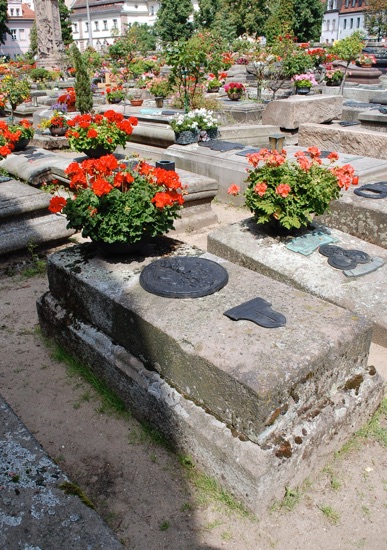
Fig 46
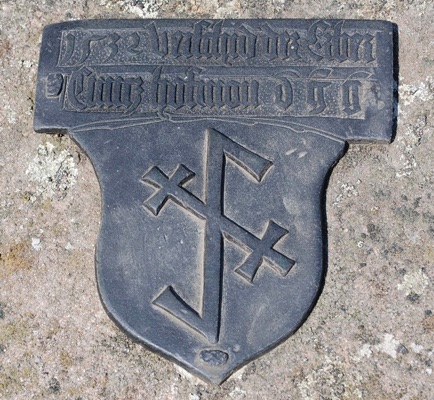
Fig 47
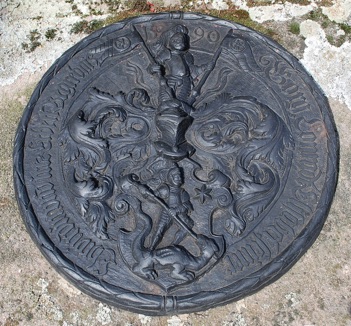
Fig 48
The second plaque (Fig 48) dates to 1590, belongs to Gorg Conrad, an iron trader (16), and seems to be unrelated.
References
5. Greif H. Nuremberg Thimblemakers. Thimble Collectors International 1986.
6. Zahn P. Die Inschriften der Friedhöfe St. Johannis, St. Rochus und Wöhrd zu Nürnberg (bis 1580). Alfred Druckenmüller Verlag, München, 1972:36 & 281.
7. Zahn P. Die Inschriften der Friedhöfe zu Nürnberg; Nachträge, Teil 2. (1581 bis 1608). Dr Ludwig Reichert Verlag, Wiesbaden, 2008:91.
8. Trechsel,Johann Martin: Verneuertes Gedächtnis des Nürnbergischen Johannis- Kirchhofs; Frankfurt, Leipzig, 1735:455.
9. Gugel, Christoph Friedrich: Norischer Christen Freydhöfe Gedächtnis....Nürnberg, 1682. pp. 77
10. Zahn P. Die Inschriften der Friedhöfe St. Johannis; St. Rochus und Wöhrd zu Nürnberg (bis 1580). Alfred Drucckenmüller Verlag, München, 1972:145.
11. Zahn P. Die Inschriften der Friedhöfe zu Nürnberg; Biographische Nachträge und Erganzungen bis 1580. Wiesbaden, 2003: 20.
12. Zahn P. Die Inschriften der Friedhöfe St. Johannis, St. Rochus und Wöhrd zu Nürnberg (bis 1580). Alfred Druckenmüller Verlag, München, 1972:296.
13 Zahn P. Die Inschriften der Friedhöfe zu Nürnberg; Nachträge, Teil 2. (1581 bis 1608). Dr Ludwig Reichert Verlag, Wiesbaden, 2008:253.
14. Zahn P. Die Inschriften der Friedhöfe zu Nürnberg; Nachträge, Teil 2. (1581 bis 1608). Dr Ludwig Reichert Verlag, Wiesbaden, 2008:297.
15. Trechsel,Johann Martin: Verneuertes Gedächtnis des Nürnbergischen Johannis- Kirchhofs; Frankfurt, Leipzig, 1735:313.
16. Zahn P. Die Inschriften der Friedhöfe zu Nürnberg; Nachträge, Teil 2. (1581 bis 1608). Dr Ludwig Reichert Verlag, Wiesbaden, 2008:180.
Holmes: na.
Researched and published in 2002/11
Copyright@2011. All Rights Reserved
Magdalena and William Isbister, Moosbach, Germany
nÜrnberg thimble maker’s graves - St Johannes ii
Navigation
